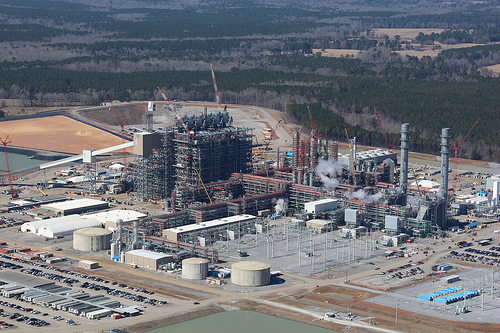Clean coal power plants face serious problems

UNDER CONSTRUCTION: The Kemper Project power plant converts lignite coal, mined near the power plant, for conversion into natural gas-like syngas to fire its turbines and generate electricity.
By Steve Wilson | Mississippi Watchdog
So-called clean coal power plants might not be the answer to new EPA regulations governing the reduction of carbon dioxide.
The EPA released Monday new requirements for Mississippi that would force the state to decrease carbon dioxide emissions 39 percent from 2005 levels. In 2012, the state expended 1,140 pounds of carbon dioxide for every megawatt generated. The EPA wants a plan from the state to decrease that to 692 pounds per megawatt-hour by 2030. The goal of the regulations is to reduce the nation’s carbon emissions 30 percent overall.
While coal isn’t as big a part of Mississippi’s energy equation as other sources — U.S. Energy Information Administration, reports Mississippi receives only 15 percent of its electrical power from coal-fired turbines — the fact most of the state’s coal-fired plants are in need of replacement makes it a contentious issue. Of the four major coal plants in the state with a capacity of 400 megawatts or more, only one (Red Hills in Choctaw County), is fewer than 30 years old.
Power companies hoping to switch to next-generation clean coal power plants that are compliant with the new regulations might find a sobering price tag. The only two integrated gasification combined cycle plants operational or under construction in the United States are plagued with technical problems and cost overruns.
Both the Duke Energy-owned Edwardsport plant in Indiana and the Southern Company’s incomplete Kemper Project in Kemper County use a process called integrated gasification to convert coal into syngas, a natural gas-like fuel for their turbines, to reduce carbon emissions.
The two plants, while using a similar process, are different to a degree. The Kemper plant is fueled by a lower-grade coal, lignite, mined nearby, whereas Edwardsport uses higher-grade bituminous coal from Indiana and other Midwestern states.
Both have been plagued by rising costs and technical issues. Edwardsport’s costs have risen to $3.7 billion, up 75 percent from the original $2 billion quoted when Indiana regulators signed off on the 618-megawatt plant’s construction in 2007. The plant’s power output, forecast to start last year at 75 percent and increase to 85 percent this year, has barely hit the 50 percent mark.
Kerwin Olson, executive director of the Citizens Action Coalition, a grassroots consumer group representing ratepayers in Indiana, has dealt with the Edwardsport plant since the process began in 2006.
‘CLEAN’ COAL: Edwardsport’s integrated gasification plant has suffered through countless delays and cost overruns.
“This is a science experiment and a new technology that’s never been developed on this scale,” Olson said. “The state of Indiana gave Duke a blank check to build it despite the warnings of experts. This is a risky and expensive proposition that ratepayers shouldn’t have to bear this cost.”
And bear it they have. Rates in Indiana, according to Olson, have gone up 16 to 18 percent — and that’s just to cover interest costs. Duke’s ratepayers in Indiana could see increases of up to 50 percent to cover the remaining costs of the plant.
Olson also said Edwardsport’s carbon-capture system doesn’t work since the site’s geology doesn’t allow carbon sequestration (trapping and storing of carbon underground). The plant’s pollution levels have increased over the former coal-fired plants that were on the same site.
Cost growth with Kemper has been constant. The Southern Company took a $380 million charge before taxes against its income in the first quarter of 2014. With the additional costs, the plant, mine and associated drag line, Kemper is expected to cost more than $5.53 billion, making it one of the most expensive power plants per kilowatt in the country.
Kemper’s prudency hearings in front of the Mississippi Public Service Commission are scheduled for August. The PSC will examine $1.75 billion in added spending for the plant. Another prudency hearing will be scheduled after the plant opens for commercial operation in May 2015, a year behind schedule. The hearings will determine whether the power company’s increased spending was prudent and can be passed on to ratepayers, who are already shouldering an 18 percent increase. If the costs are deemed wasteful, the PSC won’t allow the added costs to be passed down in the form of rate increases.
The 582-megawatt plant received a $270 million grant from the Department of Energy and $133 million in federal investment tax credits that were lost when the plant was delayed.
What does the future hold for the 187,000 customers the Southern Company has in south Mississippi? Olson said they better have their checkbooks ready.
“The ratepayers of Mississippi get to look forward to colossal rate increases in the future,” Olson said. “Those rate increases are to pay for a white elephant that’s not going to serve their needs and is not going to produce electricity to the scale to which is being promised. Ratepayers will be effectively be hosed for a lemon.”
Contact Steve Wilson at swilson@watchdog.org
Get regular updates on Mississippi through our Facebook or Twitter accounts







